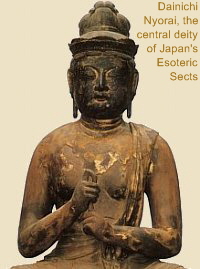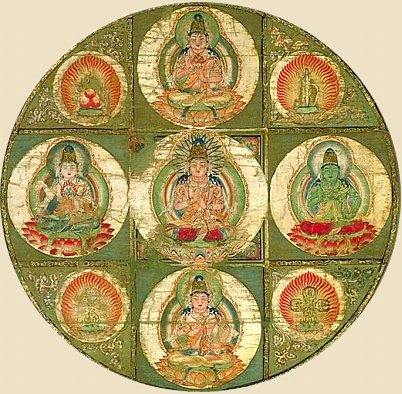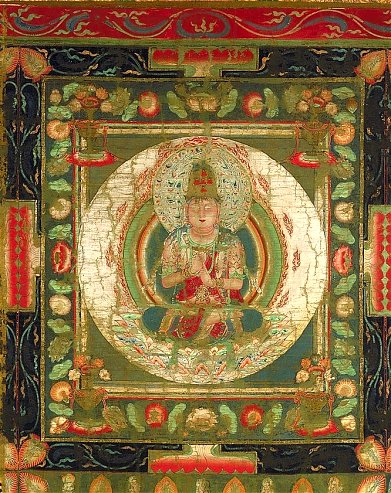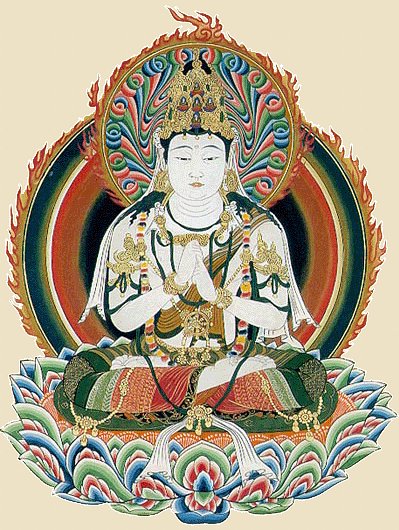|
|
|
|
  Five Buddha of Wisdom 五佛 Five Buddha of Wisdom 五佛
Five Buddha of Meditation
Five Dhyāni Buddha | Five Jina
Five Wisdom Tathagata
Godai Nyorai 五大如来 (Japanese)
Gochi Nyorai 五智如来 (Japanese)
Especially important to Japan’s Shingon 真言 and Tendai 天台 Sects of Esoteric (Tantric) Buddhsim, these Five Tathagata (Jp. = Nyorai, English = Buddha) are emanations of the absolute (transcendental) Buddha. They appear frequently in the Japanese mandala. They embody five fundamental wisdoms -- wisdom against anger, envy, desire, ignorance, and pride -- to help us break free from the cycle of death and rebirth, or the Six States of Existence (i.e., the cycle of suffering, Sanskrit = samsara). Each of the five has a specific mudra (hand gesture) that corresponds to one of five defining episodes in the life of the Historical Buddha. Each of the five is also associated with a direction, color, sense, śakti (feminine energy or complement), bīja (seed syllable-sound known as shuji 種子 in Japanese), a Dhyāni bodhisattva in two forms (one gracious, the other fierce), and a Mānuṣi-Buddha. (Note: Some Esoteric circles believe in the triple existence of each Buddha as a Nirvāṇa-Buddha, Dhyāni-Buddha, and Mānuṣi-Buddha.) Statuary and other artwork of the Bosatsu (Bodhisattva) often show them with crowns bearing an effigy of their “spiritual progenitor” -- i.e., one of the Five Buddha of Wisdom. To make matters more complex, there are various sets of the Five Buddha (Gobutsu 五仏), although Dainichi Nyorai is the central Buddha in all sets. In one of the most common groupings, the five are:
Five Great Buddha 五大如来 (Godai Nyorai)
Kongōkai Mandala 金剛界曼荼 (Skt. = Vajradhātu or Diamond Realm)
- Center = Dainichi Nyorai 大日如来 (Skt. = Vairocana / Mahāvairocana); Element = Space, Sense = Sight, Color = white. Sometimes shown on a lion. Dainichi is typically shown with hands in the Chiken-in Mudra 智拳印 (Mudra of Six Elements); mind 識 is the sixth element and is symbolized by a triangle pointing downward and by the full moon, which represents 智 wisdom or understanding. For details on the six elements, click here. Dainichi’s wrathful emanation is Fudō 不動明王 (Skt. Acalanatha).
- East = Ashuku Nyorai 阿閦如来 (Skt. = Akṣobhya); Element = Earth, Sense = Sound, Color = Blue. Sometimes shown on an elephant. Ashuku’s wrathful emanation is Gōzanze 降三世明王 (Skt. Trilokavijaya).
- South = Hōshō Nyorai 宝生如来 (Skt. = Ratnasambhava); Element = Fire, Sense = Smell, Color = Yellow. Sometimes shown on a horse. Hōshō’s wrathful emanation is Gundari 軍荼利明王 (Skt. Kundali).
- West = Amida Nyorai 阿弥陀如来 (Skt. = Amitābha); Element = Water, Sense = Taste, Color = Red. Sometimes shown on a peacock or goose. Amida’s wrathful emanation is Daiitoku 大威徳明王 (Skt. Yamantaka).
- North = Fukūjōju Nyorai 不空成就如来 (Skt. = Amoghasiddhi) or sometimes Śākyamuni; Element = Air, Sense = Touch, Color = Green. Sometimes shown on a garuda. Fukūjōju’s wrathful emanation is Kongōyasha 金剛夜叉明王 (Skt. Vajrayaksha).

Closeup from Kongōkai (Diamond) Mandala
Image in center is Dainichi Nyorai
Kyōōgokoku-ji 教王護国寺 Temple (Tōji 東寺), Heian Period, 9th C
North (Top) = Fukūjyōju | South (Bottom) = Hōshō
Left (West) = Amida | Right (East) = Ashuku (the green-colored deity)
Five Great Buddha 五大如来 (Godai Nyorai)
Taizōkai Mandala 胎蔵曼荼羅 (Skt. = Garbhadhātu or Womb World or Matrix Mandara)
Starting from the east (right), and moving in a clockwise direction, they are:
- Center = Dainichi Nyorai 大日如来, Hands in Hokkaijō-in Mudra 法界定印 (Dharma Realm Mudra)
- East = Hōtō Nyorai or Hōdō Nyorai 寶幢如來 (宝幢如来) (Skt. = Ratnaketu Tathāgata)
- South = Kaifuke ō Norai 開敷華王如来 (Skt. = Saṃkusumitarāja)
- West = Muryōju Nyorai 無量寿如来 (Skt. Amitâyus, Aparimitâyus, Amitâbha, aka Amida)
- North = Tenkuraion Nyorai 天鼓雷音如来 (Skt. = Divyadundubhimeganirghoṣa)
NOTE: The Kongōkai Mandala represents the Cosmic Buddha (aka Dainichi Nyorai), and is associated with transcendental wisdom (static, crystal clear, and adamantine truth). The Taizōkai Mandala represents the world of physical phenomenon (physical manifestations of truth) and is associated with ultimate principles (Jp. = Ri, 理). Each of the Five Buddhas represents one of the Five Wisdoms (Jp. = Gochi 五智) -- wisdom against anger, envy, desire, ignorance, and pride -- and hence their name (Five Buddha of Wisdom, Jp. = Gochi Nyorai

Closeup, Kongōkai (Kongōkai) Mandala 金剛界曼荼
Image in center is Dainichi Nyorai
Heian Period, 9th Century, Kyōgokuji Temple 京極寺 (Tōji 東寺)
Photos courtesy temple catalog

MORE DETAILS ON THE FIVE WISDOM BUDDHA
- Dainichi Nyorai 大日如来 (Sanskrit = Vairocana or Mahavairocana)
Central deity in many Japanese mandala. Buddha (Tathagata) Family; converts ignorance and bewilderment into the wisdom of primordial awareness, or the wisdom of universal lawfulness; Dainichi corresponds to the Historical Buddha's first turning of the Wheel of the Law at Deer Park in Sarnath (India), where Shaka Nyorai (the Historical Buddha) gave his first sermon after reaching enlightenment; the turning of the wheel is a metaphor for teaching the way of enlightenment; Dainichi Nyorai is known as the primordial or cosmic Buddha; Center or Zenith; White; also represents body, earth, and eye consciousness. Dainichi is the one from which “all things emanate,” the one who embodies all things, the one who represents the unity of all things; thus Dainichi encompasses the qualities of the four surrounding Buddha and is the supreme deity in esoteric Buddhism. Especially important to Japan’s Shingon 真言宗 sects; embodies realm of ultimate reality (Hokkai 法界).
- Fukūjōju (Fukujoju) Nyorai 不空成就 (Sanskrit = Amoghasiddhi)
Karma Family; converts jealousy and envy into all-accomplishing wisdom, or the wisdom required by karma for its completion; family represented by sword; sometimes associated with Tara Bosatsu. North, Green. Fukūjōju is the Tathāgata of unerring performance who teaches people how they can benefit themselves and others, as well as instilling in them the will to work for the benefit of others. (Unconfirmed. Represents Jōshosachi 成所作智 (Skt.= Krtya-anusthana-jnana); Kongōyasha Myō-ō 金剛夜叉明王 said to be Fukūjōju's wrathful Shingon manifestation; in Tendai, associated with Ususama Myō-ō 烏枢沙摩明王)
- Hōshō (Hosho) Nyorai 宝生 (Sanskrit = Ratnasambhava)
Also pronounced Hōjō 宝生. Ratna (Jewel) Family; converts pride and greed into the wisdom of equanimity, or the wisdom of essential similarity, or the ultimate equality of all living creatures; South; Yellow. Hōjō is another name for Shaka Nyorai (Historical Buddha). The name Hōjō is translated as "giving birth to treasure." It represents the treasure of Buddhist Law (dharma) that Shaka taught in his first sermon and all subsequent sermons.
- Ashuku Nyorai 阿閦 (Sanskrit = Akshobhya)
Vajra (Diamond) Family; converts anger and aggression into mirror-like wisdom; East; Blue. Asuhku represents the universal and unchanging power of Buddhist teachings. (Associated with Fudō the Immovable)
- Amida Nyorai 阿弥陀如来 (Sanskrit = Amitabha)
Padma (Lotus) Family; converts desire, lust and passion into the wisdom of discriminating awareness, or the wisdom of distinction; Amida corresponds to the meditation of the Historical Buddha under the Bodhi tree; statues typically shown Amida forming the meditation mudra (Skt. = Dhyana, Jp. = Jou-in); West; Red; Padma (Lotus) family also includes Kannon Bosatsu (Avalokiteshvara), who is one of Amida’s main attendants. Amida is also the central deity of Japan’s popular Pure Land 浄土宗 Sects, and the ruler of the Western Paradise of Ultimate Bliss (Jōdo, Gokuraku 極楽).


Dainichi Nyorai (Skt. = Vairocana / Mahavairocana)
Artwork from this site on Shingon Buddhism (KoMyo-in)

SIX ELEMENTS 六界 (Jp. = Rokukai)
In Esoteric Buddhism, the five elements (Jp. = Gogyo, Gogyō 五行) are combined with one additional element, the MIND, for a total of six. Statues or paintings of Dainichi Buddha, the central deity of Esoteric Buddhism in Japan, often portray Dainichi with a characteristic hand gesture called the Mudra of Six Elements (Chiken-in 智拳印), in which the index finger of the left hand is clasped by the five fingers of the right. This mudra symbolizes the unity of the five worldly elements (earth, water, fire, air, and space) with a six element, spiritual consciousness. Others equate the left hand with the male organ and the right hand with the female organ, and maintain that it represents, by means of sexual symbolism, the central deity of the mandala from which all the other deities emanate. According to another interpretation, the left hand represents sentient beings and the right hand the Buddha, and thus symbolizes the two-way response of the Buddha and sentient beings.
In the Mandala artform, which is of special importance to Japan’s Esoteric sects (Shingon, Tendai), the five elements are considered inanimate (this equates to the Garbhadhatu or Womb World Mandala). Only by adding the sixth element -- mind, perception, or spiritual consciousness -- do the five become animate. This equates with the Vajradhatu or Diamond World Mandala. Phrased differently, there is “unity” only when the sixth element is added. Without the sixth element, ordinary eyes see only the differentiated forms or appearances.
- Earth
- Water
- Fire
- Air (or Wind)
- Space
- the MIND (spiritual consciousness or perception)

Quote from Soothill and Hodous: 五智如來 五智五佛; 五佛; 五如來 The five Dhyāni-Buddhas, or Wisdom-Tathāgatas of the Vajradhātu 金剛界, idealizations of five aspects of wisdom; possibly of Nepalese origin. The Wisdom Buddha represents the dharmakāya or Buddha-mind, also the Dharma of the triratna, or trinity. Each evolves one of the five colours, one of the five senses, a Dhyani-bodhisattva in two forms one gracious, the other fierce, and a Mānuṣi-Buddha; each has his own śakti, i. e. feminine energy or complement; also his own bīja, or germ-sound 種子 or 印 seal, i. e. 眞言 real or substantive word, the five being for 大日 aṃ, for 阿閦 hūṃ, for 寶生 ? hrīḥ, for 彌陀 ? aḥ, for 不 空 ? āḥ. The five are also described as the emanations or forms of an Ādi-Buddha, Vajrasattva; the four are considered by others to be emanations or forms of Vairocana as the Supreme Buddha. The five are not always described as the same, e. g. they may be 藥師 (or 王) Bhaiṣajya, 多寶 Prabhūtaratna, Vairocana, Akṣobhya, and either Amoghasiddhi or Śākyamuni. Below is a classified list of the generally accepted five with certain particulars connected with them, but these differ in different places, and the list can only be a general guide. As to the Dhyāni-bodhisattvas, each Buddha evolves three forms 五佛生五菩薩, 五金剛, 五忿怒, i. e. (1) a bodhisattva who represents the Buddha's dharmakāya, or spiritual body; (2) a vajra or diamond form who represents his wisdom in graciousness; and (3) a fierce or angry form, the 明王 who represents his power against evil. (1) Vairocana appears in the three forms of 轉法輪菩薩 Vajra-pāramitā Bodhisattva, 遍照金剛 Universally Shining Vajrasattva, and 不動明王 Ārya-Acalanātha Rāja; (2) Akṣobhya's three forms are 虛空藏 Ākāśagarbha, 如意 complete power, and 軍荼利明王 Kuṇḍalī-rāja; (3 ) Ratnasaṃbhava's are 普賢 Samantabhadra, 薩埵 Sattvavajra, and 孫婆 or 降三世明王 Trailokyavijayarāja; (4) Amitābha's are 觀世音 Avalokiteśvara, 法金剛 Dharmarāja, and 馬頭明王 Hayagrīva, the horse-head Dharmapāla; (5) Amoghasiddhi's are 彌勒 Maitreya, 業金剛 Karmavajra, and 金剛夜叉 Vajrayakṣa. The above Bodhisattvas differ from those in the following list:
|
Name
|
Jp. - Chn.
|
Position
|
Element
|
Sense
|
Color
|
Skt.
Seed
|
Animal
|
Dhyāni-Bosatsu
|
Mānuṣi-Buddha
|
|
Dainichi
|
大日
|
Center
|
Space
|
Sight
|
White
|
aṃ
|
Lion
|
Fugen
|
Krakucchanda
|
|
Ashuku
|
阿閦
|
East
|
Earth
|
Sound
|
Blue
|
hūṃ
|
Elephant
|
Vajrapāṇ
|
Kanakamuni
|
|
Hōshō
|
寶生
|
South
|
Fire
|
Smell
|
Yellow
|
aḥ ?
|
Horse
|
Ratnapāṇ
|
Kāśyapa
|
|
Amida
|
阿弥陀
|
West
|
Water
|
Taste
|
Red
|
hrīḥ ?
|
Goose or Peacock
|
Kannon
|
Śākyamuni
|
|
Fukūjōju
|
不空成就
|
North
|
Air
|
Touch
|
Green
|
āḥ ?
|
Garuḍa
|
Visvapāṇi ?
|
Miroku
|
NOTE FROM SITE AUTHOR: Entries with a question mark (?) are uncomfirmed.

LEARN MORE

|
|